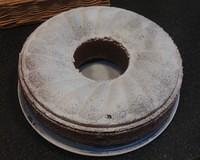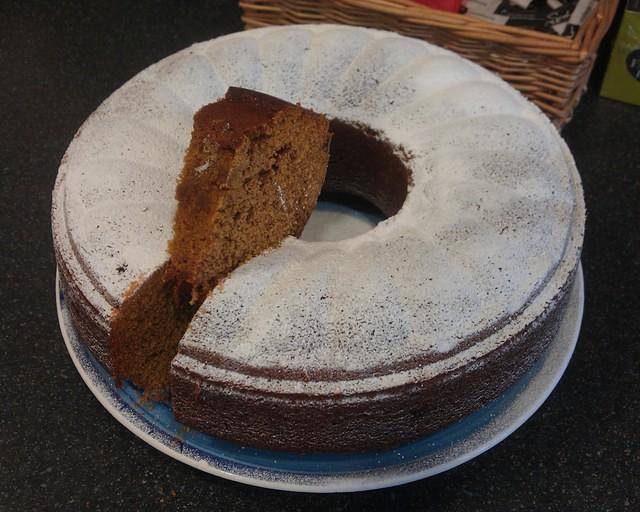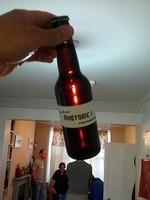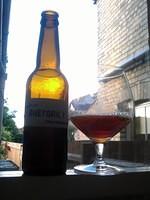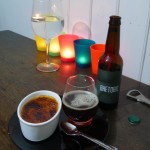 Crème brûlée really isn’t at all difficult to make and it an excellent dessert to produce in bulk to impress people on special occasions. It also gives a great excuse to have a blowtorch in the kitchen.
Crème brûlée really isn’t at all difficult to make and it an excellent dessert to produce in bulk to impress people on special occasions. It also gives a great excuse to have a blowtorch in the kitchen.
This particularly rich crème brûlée is inspired by a trip to Musa Aberdeen back around the first BrewDog AGM. Kat had a Paradox Smokehead crème brûlée and has been talking about it ever since… our supply of Smokehead ran out long ago, so I set about putting together a version using a complex & tasty beer from Hardknott instead. Hardknott Rhetoric Ed.1 is described as “Star Anise Infused Quasi-Bombastic Belgique Quad” which hit me as a pretty good flavour element to add to the custard — anise spice combined with boozy Belgian body.
Ingredients
- 300ml double cream (1 typical supermarket pot)
- 100ml Hardknott Rhetoric Ed.1 (leaving plenty to enjoy while cooking)
- 40g golden caster (plus a little more for later)
- 4 good free-range eggs – yolks only
Method
The tricky part of producing a crème brûlée is cooking it right. I suggest pre-preparing for the baking first. You need to pre-heat your oven to 160C (gas mark 3, 325F) and have ramekins, or similar, ready for filling. This recipe makes about 450ml of liquid and you should fill your ramekins close to their tops. They should be baked in a hot water bath coming up about 2 thirds of their height. To this end choose an appropriately deep oven dish to bake them in, preferably such that the rim of the oven dish is higher than that of the ramekins. This allows you to place a baking tray over the top to keep the tops of the custards moist so they don’t brown. Have a kettle full of water boiled and waiting.
In a small saucepan mix together the double cream and beer and then heat until just barely simmering
While the cream and beer mixture is heating beat the yolks and caster sugar together until thick and creamy. Easiest to use an electric mixer for this.
When the double cream and beer is heated carefully whisk into the egg mixture. Don’t whisk too vigorously as then you’ll end up with a lot of foam. Once done let sit for half a minute then, using a large metal spoon, carefully skim off any foam (chef’s perk!)
Place ramekins into their baking dish and fill with the custard mixture, preferably to quite close to their rims. Then fill the dish with freshly boiled water to about 2 thirds up the height of the ramekins. Place them in the oven, covering the baking dish with a flat pan but leaving a crack open at one edge to let excess steam escape.
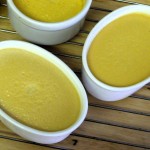 These should need about 30 minutes in the oven, perhaps a little more. When they’re done they should still be quite wobbly in the middle but not runny. They seemed to have “fizzed” a little during cooking as the top surface was bubbly, not surprising given the light carbonation in the beer. This didn’t seem to do them any damage however, but I’d not want to try it with a particularly fizzy beer.
These should need about 30 minutes in the oven, perhaps a little more. When they’re done they should still be quite wobbly in the middle but not runny. They seemed to have “fizzed” a little during cooking as the top surface was bubbly, not surprising given the light carbonation in the beer. This didn’t seem to do them any damage however, but I’d not want to try it with a particularly fizzy beer.
Cool for a minute on a wire rack then get them into the fridge. They should be in the fridge for at least a couple of hours before serving and are fine prepared a day in advance.
 When the time to serve them comes sprinkle with golden caster sugar until well coated. Tip off excess sugar then evenly sprinkle over a little more. Wipe clean the rims of the ramekins and make use of a blowtorch to brown the sugar thoroughly, don’t be afraid of a little smoke — but don’t overdo it! This can also be done under a hot overhead grill.
When the time to serve them comes sprinkle with golden caster sugar until well coated. Tip off excess sugar then evenly sprinkle over a little more. Wipe clean the rims of the ramekins and make use of a blowtorch to brown the sugar thoroughly, don’t be afraid of a little smoke — but don’t overdo it! This can also be done under a hot overhead grill.
Serve with a glass of Rhetoric Ed.1!
I made just two crème brûlées with this recipe. Thoroughly decadent! Larger custards also increases the baking time, to about 40 minutes. I recommend using four smaller ramekins, about 120ml in size. If you make 4 then you’re looking at something approaching 500 Calories each. This is a very rich dessert, you have been warned…

